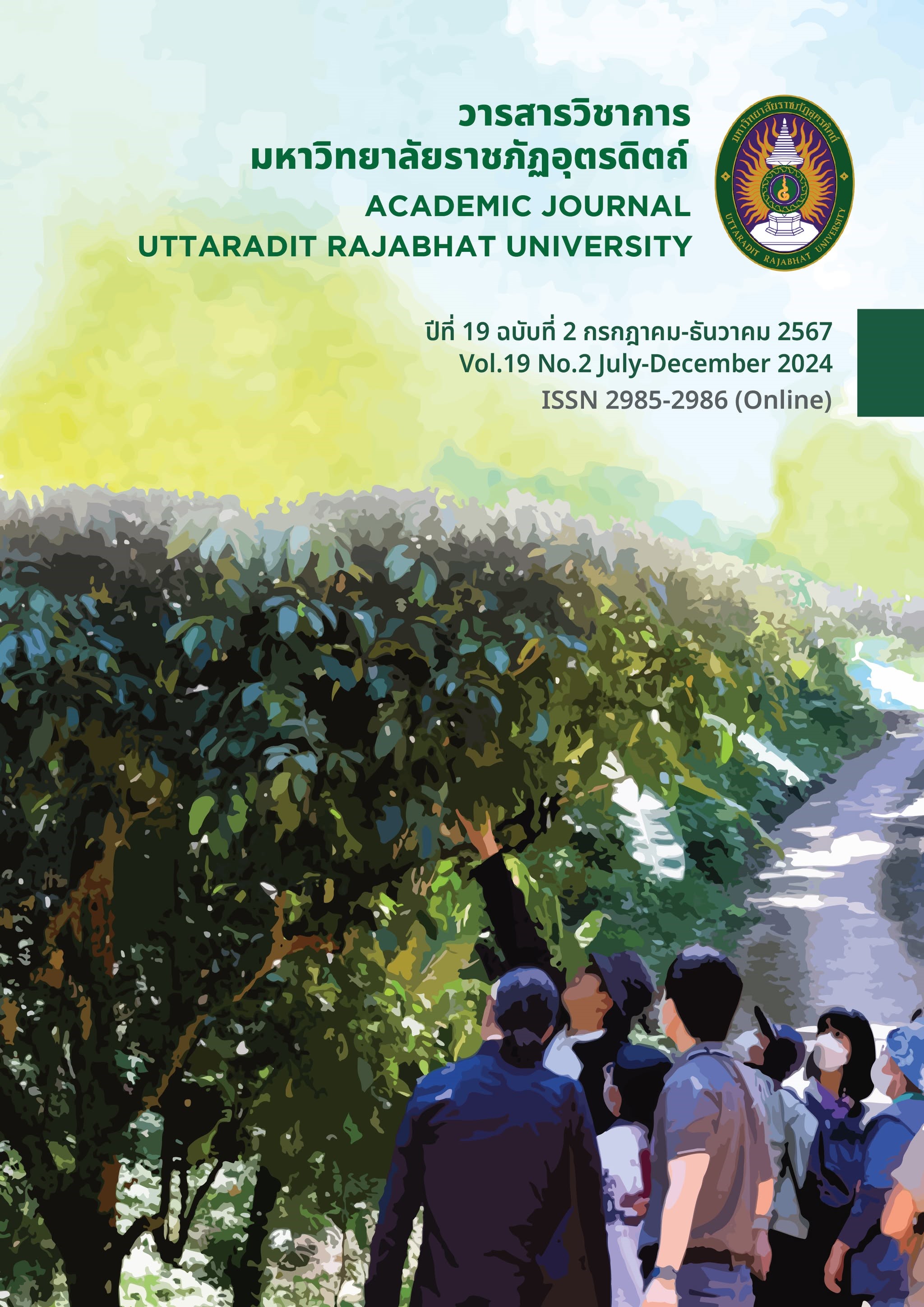MENTAL HEALTH PROBLEMS IN ELDERLY PATIENT WITH CHRONIC DISEASES CHIANG RAI PROVINCE
Main Article Content
Abstract
The objectives of this research were to assess the mental health assessment and factors affecting mental health problems in the elderly patients with chronic diseases in Chiang Rai province. The population and sample consisted of elderly patients with chronic diseases in Chiang Rai province. The research used a multi-stage random sampling method by stratifying Chiang Rai Province into 4 areas according to the public health operations of the Chiang Rai Provincial Public Health Office and simple random sampling was conducted by drawing lots for districts in Chiang Rai Province at a ratio of 5:1 from all 18 districts and drawing lots for sub-districts at a ratio of 5:1. It was found that 8 sub-districts were the sample group in a sample size of 400 persons. Research tools consisted of the 20-question stress assessment forms of The Suanprung Stress Test 20 [SPST-20] and State-Trait Anxiety Inventory Y-1 [STAI form Y-1], and the 15-question assessment form of Thai Geriatric Depression Scale: TGDS. According to the findings of a general data analysis of 400 elderly patients with chronic diseases, the majority of the samples were female of 204 individuals representing 51.0% with an average age of 68.2 years. 206 persons accounted for 51.5% were between the age of 60 and 69 years. Accounted for 32.0%, 128 persons completed primary school. Accounted for 48.8%, 195 persons experienced moderate stress. Accounted for 51.2%, 205 persons experienced moderate anxiety. Accounted for 51.5%, 206 persons suffered from moderate depression. Furthermore, the factors affecting mental health problems in the elderly with chronic diseases revealed that gender was found to be significantly associated with all of the three components of mental health. Moreover, family relationships were found to be related to stress. Relevant agencies should screen, monitor and create special activities for different groups of elderly patients in terms of gender and their chronic disease history.
Downloads
Article Details

This work is licensed under a Creative Commons Attribution-NonCommercial-NoDerivatives 4.0 International License.
References
กรมสุขภาพจิต กระทรวงสาธารณสุข. (2558). แนวทางการดูแลทางด้านสังคมจิตใจของผู้สูงอายุ เพื่อป้องกันปัญหาสุขภาพจิต (ฉบับปรับปรุงครั้งที่ 1). (พิมพ์ครั้งที่ 4). ชุมนุมสหกรณ์การเกษตรแห่งประเทศไทย.
กรมกิจการผู้สูงอายุุ. (2566). สถานการณ์ผู้สูงอายุไทย พ.ศ. 2565. อมรินทร์ คอร์เปอเรชั่นส์ จำกัด (มหาชน).
กุลธิดา ดวงเนตร. (2564). ความชุกและปัจจัยที่สัมพันธ์กับภาวะซึมเศร้าในผู้ป่วยโรคไม่ติดต่อเรื้อรัง ในหน่วยงานบริการปฐมภูมิ โรงพยาบาลภูเขียวเฉลิมพระเกียรติ. วารสารการแพทย์โรงพยาบาลศรีสะเกษ สุรินทร์ บุรีรัมย์, 36(1), 13-24.
ขนิษฐา ตลอดภพ, วรรณภา ประทุมโทน, อังคณา เรือนก้อน, และเริงนภรณ์ โม้พวง. (2556). ปัจจัยที่มีผลต่อความเครียดของผู้สูงอายุ ต.บ้านคลอง อ.เมือง จ.พิษณุโลก. วารสารวิชาการและวิจัย มทร.พระนคร ฉบับพิเศษ การประชุมวิชาการมหาวิทยาลัยเทคโนโลยีราชมงคล ครั้งที่ 5, 174-179.
คณะพยาบาลศาสตร์ จุฬาลงกรณ์มหาวิทยาลัย และสำนักงานกองทุนสนับสนุนกาารสร้างเสริมสุขภาพ (สสส.). (2561). เรียนรู้เข้าใจวัยสูงอายุ โครงการพัฒนาคุณภาพชีวิตผู้สูงอายุในเขตกรุงเทพมหานคร. ผู้แต่ง.
ชนัตต์ โอฬารธนาเศรษฐ์. (2566). ความชุกและปัจจัยที่มีความสัมพันธ์กับภาวะซึมเศร้าในสถานการณ์การแพร่ระบาดโรคโควิด-19 ของประชาชนเขตศูนย์แพทย์ชุมชนเมือง 2 โรงพยาบาลมหาราชนครราชสีมา จังหวัดนครราชสีมา. วารสารระบบบริการปฐมภูมิและเวชศาสตร์ครอบครัว, 6(2), 179-188.
ณัฐปภัสญ์ นวลสีทอง, ธัญรัศม์ ภุชงค์ชัย, อ้อยทิพย์ บัวจันทร์, และภัควรินทร์ ภัทรศิริสมบูรณ์. (2564). ความเครียดและภาวะซึมเศร้าของผู้สูงอายุที่เป็นโรคเรื้อรัง ตำบลนาเสียว อำเภอเมือง จังหวัดชัยภูมิ. วารสารสาธารณสุขมหาวิทยาลัยบูรพา, 16(2), 78-89.
ดมิสา เพชรทอง, ดาราวดี รักวงค์, นูไรดา แสสาเหตุ, อาริสา พันธุสะ, สมเกียรติยศ วรเดช, และปุญญพัฒน์ ไชยเมล์. (2563). การส่งเสริมสุขภาพผู้สูงอายุในชุมชน: ความเครียดและแนวทางการจัดการความเครียด.วารสารวิชาการสาธารณสุขชุมชน, 6(1), 1-11.
นันทิดา ทองอ้ม. (2565). การศึกษาความชุกของภาวะซึมเศร้าและปัจจัยที่มีผลต่อการเกิดภาวะซึมเศร้าในผู้สูงอายุที่มารับบริการแผนกผู้ป่วยนอก โรงพยาบาลศีขรภูมิ จังหวัดสุรินทร์. วารสารการแพทย์โรงพยาบาลศรีสะเกษ สุรินทร์ บุรีรัมย์, 37(2), 311-320.
ปิติคุณ เสตะปุระ และณัฐธกูล ไชยสงคราม. (2564). ความชุกและปัจจัยที่เกี่ยวข้องกับภาวะซึมเศร้าของผู้สูงอายุในประเทศไทย ปี พ.ศ. 2564. วารสารศูนย์อนามัยที่ 9, 16(3), 1070-1084.
พรทิพย์ สารีโส, ปิยะภร ไพรสนธิ์, อุษาษ์ โถหินัง, วรางคณา อ่ำศรีเวียง, และนารีลักษณ์ ฟองรัตน์. (2560). สถานการณ์ ปัญหาสุขภาพและความต้องการการดูแลของผู้สูงอายุโรคเรื้อรัง: เขตเทศบาลเมืองเชียงราย. วารสารพยาบาลศาสตร์และสุขภาพ, 40(2), 85-95.
มกรารัตน์ หวังเจริญ. (2565). ความชุกและปัจจัยที่มีสัมพันธ์กับภาวะซึมเศร้าของผู้สูงอายุในชุมชนเขตรับผิดชอบของโรงพยาบาลส่งเสริมสุขภาพตำบลโนนสมบูรณ์ อำเภอบ้านแฮด จังหวัดขอนแก่น. วารสารศูนย์อนามัยที่ 7 ขอนแก่น, 14(2), 50-66.
มาติกา รัตนะ. (2559). ความชุกและปัจจัยที่สัมพันธ์กับภาวะซึมเศร้าในผู้สูงอายุ จังหวัดพระนครศรีอยุธยา [การค้นคว้าอิสระปริญญามหาบัณฑิต, มหาวิทยาลัยธรรมศาสตร์]. https://ethesisarchive.library.tu.ac.th/thesis/2016/TU_2016_5417030417_2978_3953.pdf
มินตรา สาระรักษ์, ญฌา จันทร์ทรง, และสุพรรษา ชูตระกูลกิจ. (2565). ปัจจัยที่มีความสัมพันธ์กับภาวะซึมเศร้าของผู้สูงอายุที่ป่วยด้วยโรคไม่ติดต่อเรื้อรังที่เข้ารับบริการในโรงพยาบาลส่งเสริมสุขภาพตำบลโพธิ์ใหญ่ อำเภอวารินชำราบ จังหวัดอุบลราชธานี [การนำเสนอโปสเตอร์]. การประชุมวิชาการระดับชาติ มอบ. วิจัย ครั้งที่ 16. มหาวิทยาลัยอุบลราชธานี. https://www.ubu.ac.th/web/files_up/00008f2022090117360648.pdf
สถาบันเวชศาสตร์สมเด็จพระสังฆราชญาณสังวรเพื่อผู้สูงอายุ. (2552). คู่มือมาตรฐานและการดำเนินงาน คลินิกผู้สูงอายุคุณภาพ. กรมการแพทย์ กระทรวงสาธารณสุข.
สายฝน เอกวรางกูร. (2554). รู้จัก เข้าใจ ดูแลภาวะซึมเศร้า. (พิมพ์ครั้งที่ 2). สำนักพิมพ์แห่งจุฬาลงกรณ์มหาวิทยาลัย.
สำนักงานสถิติแห่งชาติ สำนักสถิติเศรษฐกิจและสังคม. (2559). การสำรวจสุขภาพจิต (ความสุข) คนไทย พ.ศ. 2558. กลุ่มสถิติแรงงาน สำนักสถิติเศรษฐกิจและสังคม สำนักงานสถิติแห่งชาติ.
สุชาดา แซ่ลิ่ม. (2562). การศึกษาความชุกและปัจจัยที่มีผลต่อภาวะซึมเศร้าของผู้สูงอายุในอำเภอเมือง จังหวัดระนอง. วารสารวิชาการแพทย์เขต 11, 33(1), 193-202.
สุวัฒน์ มหัตนิรันดร์กุล, วนิดา พุ่มไพศาลชัย, และพิมพ์มาศ ตาปัญญา. (2540). การสร้างแบบวัดความเครียดสวนปรุง. วารสารสวนปรุง, 13(3), 1-20.
Foundation of Thai Gerontology Research and Development Institute (TGRI). (2016). Situation of the Thai elderly 2014. Amarin printing and publishing. https://www.dop.go.th/download/knowledge/knowledge_th_20161608145327_1.pdf
Park, Jong-ll., Park, T. W., Yang, Jong-Chul., & Chung, Sang-Keun. (2016). Factors associated with depression among elderly Koreans: the role of chronic illness, subjective health status, and cognitive impairment. The official journal of the Japanese Psychogeriatrics Society, 16(1), 62-69. https://doi.org/10.1111/psyg.12160
Prasartkul, P. (2016). Situation of the Thai Elderly 2014. Amarin printing and publishing.
Spielberger, C. D. (1983). Manual for the State-Trait-Anxiety Inventory: STAI (form Y). Consulting Psychologists Press.
Wayne, W. D. (1995). Biostatistics: A Foundation for Analysis in the Health Sciences. Biometrical journal, 37(6), 744. https://doi.org/10.1002/bimj.4710370610


